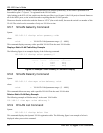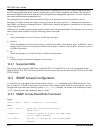
IES-1000 User’s Guide
IEEE 802.1p Priority Commands 10-1
Chapter 10
IEEE 802.1p Priority Commands
This chapter explains IEEE 802.1p Priority CI Commands.
10.1 Introduction
IEEE 802.1p Priority CI Commands provide priority changes for ports. IEEE 802.1p defines up to eight priorities
(0-7) by inserting a tag into a MAC-layer frame that contains bits to define priority of service.
10.2 IEEE 802.1p Priority Commands
Bridge port 1 stands for the Ethernet port, bridge port 2 stands for DSL port 1, bridge port 3 stands for DSL
port 2, and so on.
10.2.1 Priority Port Command
Syntax:
192.168.1.1 vlan1q> priority port <port #> <priority>
where
<port #> =
bridge port number. Valid parameter range = [1 - 9].
<priority> =
default priority for the specified port. Valid parameter range = [0 - 7], where 0 is
the lowest priority and 7 is the highest priority.
This command sets the default priority for an ingress port.
To display the default port priority table, simply use the Priority Port command without parameters, as shown
next.
192.168.1.1 vlan1q> priority port
10.2.2 Regen Port Command
Syntax:
192.168.1.1 vlan1q> regen port [<port #> <user priority> <regened
priority>]
where
<port #> =
bridge port number. Valid parameter range = [1 – 9].
<user priority> =
the user priority for a frame received on this port. Valid parameter
range = [0 - 7], where 0 is the lowest priority and 7 is the highest
priority.
<regened priority> =
the regenerated user priority the incoming user priority is mapped to for
<port #>. Valid parameter range = [0 - 7], where 0 is the lowest


















